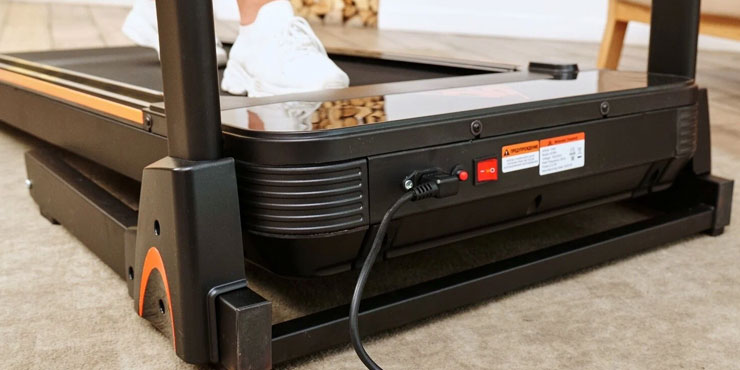How to Clean a Treadmill Belt
Treadmills, a staple of many home gyms and fitness centers, are often subjected to rigorous use. Just as we sweat and exert ourselves during our workouts, these machines bear the brunt of our exercise routines. At the heart of the treadmill’s operation is its belt, which, if neglected, can become a repository for dust, sweat and debris. Understanding how to clean a treadmill belt isn’t just about aesthetics or hygiene; it’s a critical aspect of equipment maintenance.
Regular cleaning provides three main benefits: it prolongs the life of the equipment, protects users from potential accidents, and ensures optimal performance during every workout. In this article, we’ll look at the importance of keeping your belt in pristine condition and the best practices for doing so.
Contents
- Why Cleaning the Treadmill Belt is Essential?
- Safety Concerns
- Performance Impediments
- Durability and Longevity
- What breakdowns can occur?
- Signs Your Treadmill Belt Needs Cleaning
- Inconsistent movement and slippage
- Obvious accumulation of debris
- Unusual noises from the machine
- Drop in Operating Efficiency
- Materials Needed
- Soft cloth or towel
- Gentle cleaning solution
- Soft Bristle Brush
- Vacuum with a Hose Attachment (Optional)
- Step-by-Step Guide to Cleaning the Treadmill Belt
- 1. Unplug the Treadmill
- 2. Vacuum Around and Underneath the Treadmill
- 3. Clean the Surface
- 4. Remove Stubborn Stains
- 5. Dry the Belt
- 6. Regular Maintenance
- Tips and Precautions
- Conclusion
- Frequently Asked Questions (FAQs)
Why Cleaning the Treadmill Belt is Essential?
Treadmills, like any other piece of equipment, require regular maintenance to function optimally. One of the most overlooked aspects of this maintenance is belt cleaning. But why is it so important? Let’s take a closer look at the reasons:
Safety Concerns
Slippery surfaces: A treadmill belt covered with sweat, dust or any form of debris can become slippery. This poses a significant risk to users because they can lose their footing during a workout. Slipping can lead to anything from minor injuries such as sprains to more serious injuries such as broken bones or head trauma. Keeping the belt clean minimizes this risk and provides a safer workout environment.
Uneven traction: Dirt and debris can also cause uneven traction on the surface of the belt. This unevenness can be disorienting to users, leading to missteps and potential accidents.
Performance Impediments
Belt movement: Dirt and debris can get trapped between the belt and the platform or in the rollers, causing the belt to move unevenly or jerk during use. This not only disrupts a smooth workout experience, but can also stress the motor as it tries to maintain a consistent speed.
Motor Efficiency: The motor is the heart of the treadmill. As dirt and debris accumulate, they can enter the motor compartment. This can lead to increased friction, causing the motor to work harder than necessary. Over time, this can reduce the efficiency of the motor, leading to overheating or even premature failure.
Durability and Longevity
Maintaining the Belt: The constant accumulation of dirt and sweat can degrade the material of the belt over time. This degradation can manifest itself as cracking, fraying or general wear and tear. A clean belt, free of abrasive particles and corrosive perspiration, tends to last longer and perform more effectively.
Extend the life of your treadmill: In addition to the belt, the entire treadmill benefits from regular cleaning. By keeping dirt and debris out of the inner workings of the machine, you’ll reduce wear and tear on its components. This not only means fewer repairs, but it also extends the overall life of the treadmill, giving you more value for your investment.
What breakdowns can occur?
Neglecting to clean and maintain your belt can lead to a cascade of problems that affect both the performance of the machine and your overall workout experience. Here’s a detailed breakdown of the potential malfunctions that can occur when the belt is not properly maintained:
- Reduced belt life: As dirt, dust and debris accumulate on the deck, they create a gritty, abrasive surface. As you continue to use the treadmill, this constant friction can cause accelerated wear of the belt material. Over time, this can lead to cracking, fraying or even complete belt failure. A neglected belt may need to be replaced sooner than expected, resulting in additional cost and inconvenience.
- Engine stress and inefficiency: A dirty belt doesn’t just affect the belt itself; it can also affect the equipment’s motor. As the belt becomes clogged with debris, the motor has to work harder to maintain the desired speed. This increased workload can stress the motor, causing it to work harder and heat up excessively. Inefficient motor performance not only affects the quality of your workout, but can also lead to premature motor burnout, requiring costly repairs or replacement.
- Uneven belt movement: Accumulated dirt and debris can disrupt the smooth movement of the treadmill belt. This uneven movement can create an uneven and uncomfortable workout experience. You may feel jolts or slippage as you walk or run, potentially throwing off your balance and form. Over time, these irregularities can cause discomfort, reduce the effectiveness of your workout, and even increase the risk of injury.
- Increased noise levels: Debris trapped between the belt and deck or rollers can create friction, resulting in increased noise levels during operation. The machine may begin to emit squeaks, squeaks, or grinding noises that not only disrupt your workout environment, but may also indicate mechanical problems that require attention. Ignoring these noises could lead to more serious problems down the road.
- Safety hazards: A dirty belt can become slippery due to sweat, dirt or debris buildup. This is a serious safety hazard because it increases the risk of slips and falls during your workout. Even minor accidents can result in injury, affecting your fitness routine and overall well-being.
- Reduced workout effectiveness: As the performance of the belt is compromised, your workouts may become less effective. Inaccurate speed and incline settings, uneven traction, and discomfort can hinder your ability to achieve your fitness goals. This can be frustrating and demotivating, and may lead to a decline in your exercise routine.
Signs Your Treadmill Belt Needs Cleaning
Treadmills give off certain signals when they’re not in their best condition. Recognizing these signs early can save you from potential accidents, costly repairs, or a compromised workout. Here are some indicators that your treadmill belt might be crying out for a thorough cleaning:
Inconsistent movement and slippage
If you notice that the belt isn’t moving moothly or you feel an unexpected shift underfoot, it’s a clear sign of trouble. Slippage or uneven movement can be caused by debris caught between the belt and the deck or rollers. This not only disrupts your workout rhythm, but can also be a safety hazard, increasing the risk of falls or missteps.
Obvious accumulation of debris
Over time, it’s natural for a layer of dust, dirt or even sweat to build up on the surface of the belt. If you can see it, or if the belt feels gritty, it’s time for a cleaning. Ignoring this can cause the belt material to deteriorate faster than usual.
Unusual noises from the machine
A well-maintained treadmill operates with a consistent hum. However, if you begin to hear unusual noises, such as squeaks, grinding, or other abnormal sounds, it may indicate that dirt or debris is affecting the machine’s components. Don’t ignore these noises, as they can be a harbinger of more serious mechanical problems.
Drop in Operating Efficiency
If your treadmill seems to struggle to maintain its set speed, or if it feels less responsive to input changes, a dirty belt may be affecting the motor’s performance. Dirt and debris can increase friction, causing the motor to work harder and reduce its efficiency. This not only affects your workout, but also puts stress on motor, potentially shortening its lifespan.
In essence, being aware of these signs and acting promptly can ensure that your Treadmill remains in top condition, providing you with a safe and effective workout for years to come. Regular inspection and cleaning are small investments in the longevity and performance of your equipment.
Materials Needed
Cleaning your belt is a simple process, but having the right materials on hand can make the task more efficient and effective. Here’s a breakdown of the essential items you’ll need, along with specific product suggestions:
Soft cloth or towel
Description: A soft cloth or towel is essential for wiping down the treadmill belt without causing abrasions. It’s best to use a lint-free cloth to avoid leaving residue behind.
Product Suggestions: Microfiber cleaning cloths, which are widely available in stores, are excellent for this purpose. Brands such as Zwipes or AmazonBasics offer high-quality microfiber cloths that are both absorbent and gentle on surfaces.
Gentle cleaning solution
Description: A mild cleaning solution helps to effectively remove dirt, sweat, and other residue without damaging the belt material.
Specific Suggestions: Commercial belt cleaners, such as Impresa Products Treadmill Belt Cleaner, are formulated specifically for this purpose.
DIY Mixes: For those who prefer a homemade solution, a mixture of equal parts distilled water and white vinegar can be effective. Another option is a few drops of mild dish soap diluted in a large amount of water. Remember, it’s important to make sure the solution is not too soapy or harsh.
Soft Bristle Brush
Description: A soft-bristled brush can help remove stubborn dirt or stains without scratching the belt.
Product Suggestions: Brushes designed for delicate surfaces, such as shoe brushes or car detailing brushes, can be ideal. The Chemical Guys Soft Cleaning Brush is one such product that’s gentle yet effective.
Vacuum with a Hose Attachment (Optional)
Description: A vacuum can be useful in removing loose dirt, dust and debris from around and under the treadmill. The wand allows for more precise cleaning, especially in hard-to-reach areas.
Product Suggestions: Most household vacuums come with a wand. Brands such as Dyson, Shark, or Hoover have models with versatile attachments that work well for this task.
When shopping for these materials, it’s always a good idea to check the owner’s manual for your vacuum. Manufacturers may have specific recommendations or warnings about products that should or shouldn’t be used on their machines.
Step-by-Step Guide to Cleaning the Treadmill Belt
Maintaining a clean treadmill belt is not just about ensuring a smooth workout; it’s about safety, longevity, and optimal performance. Here’s a comprehensive guide to help you clean your treadmill belt effectively:
1. Unplug the Treadmill
- Action: Before you begin, ensure the treadmill is turned off. Then, unplug it from the power source.
- Why: This is a crucial safety step to prevent any accidental startups or electrical issues while cleaning.
- Potential Difficulty: Forgetting to unplug or accidentally turning it on.
- Solution: Always double-check that the machine is unplugged and inform others in the household that you’re cleaning the treadmill to avoid any unintentional startups.
2. Vacuum Around and Underneath the Treadmill
- Action: Using a vacuum cleaner with a hose attachment, vacuum the area around and underneath the treadmill. You should also lubricate the underside of the belt in this occasion.
- Why: This removes any loose dust, dirt, and debris, preventing them from getting onto the belt or inside the mechanics.
- Potential Difficulty: Reaching tight spaces or areas under the treadmill.
- Solution: Use the hose attachment or a crevice tool on your vacuum to access hard-to-reach areas. If necessary, slightly lift or tilt the treadmill (with assistance) to clean underneath.
3. Clean the Surface
- Action: Mix your cleaning solution. You can use a commercial treadmill cleaner or a DIY mix of equal parts distilled water and white vinegar.
- Dampen a soft cloth or towel with the solution. Ensure it’s moist but not dripping wet.
- Wipe down the belt thoroughly, moving from one end to the other.
- Why: This step ensures the removal of sweat, grime, and other residues from the belt’s surface.
- Potential Difficulty: Over-wetting the belt, which can seep into the treadmill’s internals.
- Solution: Always wring out the cloth or towel thoroughly before wiping. It should be damp, not wet.
4. Remove Stubborn Stains
- Action: If you notice any stubborn spots or streaks, use a soft-bristled brush to gently scrub them away.
- Why: Some stains might not come off with a simple wipe and need a bit more attention.
- Potential Difficulty: Scrubbing too hard and damaging the belt.
- Solution: Always use a soft-bristled brush and apply gentle pressure. If a stain doesn’t come off easily, let the cleaning solution sit on it for a few minutes before scrubbing.
5. Dry the Belt
- Action: After cleaning, use a dry cloth to wipe down the belt, ensuring it’s completely dry.
- Why: A damp belt can become slippery and may also harbor mold or mildew over time.
- Potential Difficulty: Leaving the belt damp or not drying it evenly.
- Solution: Use a dry, absorbent cloth and consider running the treadmill at a slow speed for a few minutes to air-dry any remaining dampness.
6. Regular Maintenance
- Discussion: Cleaning your belt isn’t a one-time task. Regular maintenance ensures the machine’s longevity and optimal performance. It’s advisable to clean the belt at least once a month, or more frequently if the treadmill sees heavy use.
- Potential Difficulty: Forgetting or neglecting regular cleaning.
- Solution: Set a monthly reminder on your phone or calendar to ensure you don’t forget this essential maintenance task.
By following this guide, you’ll ensure that your treadmill remains in top condition, providing you with safe and efficient workouts for years to come. In addition, we also recommend watching the video that shows the process in detail:
Tips and Precautions
When it comes to cleaning your belt, a few simple tips and precautions can go a long way in ensuring that your machine remains in great condition and provides you with safe and effective workouts. Here’s what you need to know:
Avoid Harsh Chemicals and Abrasive Brushes: It’s tempting to use strong cleaning agents or rough brushes to tackle stubborn stains, but this approach can do more harm than good. Harsh chemicals might damage the belt material and lead to premature wear and tear. Similarly, abrasive brushes can cause scratches, which could affect the belt’s texture and overall performance. Instead, opt for mild cleaning solutions, such as a mixture of distilled water and white vinegar. When selecting brushes, choose soft-bristled ones that won’t scratch the surface. Your aim is to clean, not damage.
Unplug the Treadmill Before Cleaning: Safety should be a top priority whenever you’re working with electrical appliances. Before you even think about cleaning your treadmill belt, ensure the machine is turned off and unplugged. This simple step eliminates the risk of accidental start-ups while you’re cleaning. Even if you’re just wiping down the belt, unplugging the treadmill is a crucial precaution to avoid any electrical mishaps.
Refer to the Manufacturer’s Instructions: Every treadmill model is unique, and manufacturers often provide specific guidelines for cleaning and maintenance. It’s wise to consult the user manual that came with your treadmill. This document typically includes valuable information on recommended cleaning solutions, techniques, and any products you should avoid. Following the manufacturer’s instructions ensures you don’t inadvertently use something that could damage the belt or the treadmill’s internal components.
Consider Using a Treadmill Mat: Placing a mat underneath your machine might seem like a small detail, but it can have a big impact on maintenance. A mat serves as a protective barrier between the treadmill and the floor. Not only does it help reduce vibrations and noise, but it also prevents dirt, dust, and debris from accumulating underneath the treadmill. By using a mat, you minimize the chances of foreign particles finding their way onto the belt and into the treadmill’s mechanisms.
Conclusion
In the journey towards a healthier and more active lifestyle, it’s easy to overlook the critical role that proper treadmill maintenance plays. As we’ve explored in detail, cleaning the treadmill belt is not a mere chore but a fundamental responsibility that directly influences your workout quality, machine longevity, and safety. A clean treadmill belt ensures smooth, consistent movement, reduces strain on the motor, and minimizes the risk of slips or accidents. It’s an investment in your health and fitness, providing a reliable platform for achieving your exercise goals.
Incorporating treadmill belt cleaning into your regular maintenance routine is a simple yet invaluable step. Just as you wouldn’t neglect oil changes for your car, regular treadmill maintenance is essential for optimal performance. As you’ve seen, the consequences of ignoring this aspect of upkeep can range from premature wear and tear to compromised workout effectiveness. By setting aside a few moments each month to clean and care for your treadmill belt, you’re actively extending the lifespan of your equipment, maximizing the benefits of your workouts, and prioritizing your well-being.
So, let’s make a pact to keep our treadmill belts clean and well-maintained, reflecting the dedication we have towards our fitness journeys. Embracing this practice ensures that your treadmill becomes a steadfast partner in achieving your fitness aspirations, supporting you every step of the way.
Frequently Asked Questions (FAQs)
How often should I clean my treadmill belt?
Can I use any household cleaner on my treadmill belt?
How do I know if my treadmill belt needs replacing?
Is it safe to use a wet cloth on the treadmill?










